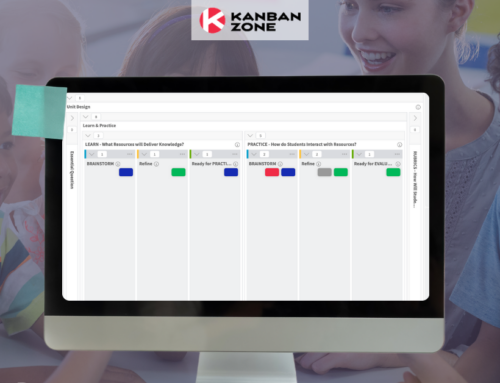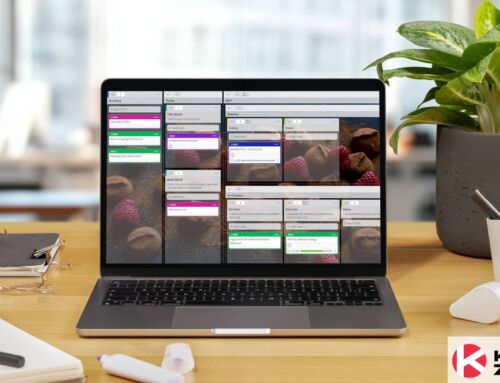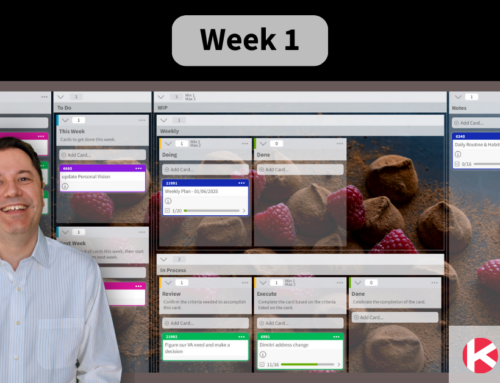
Kanban is such a simple and effective approach to improving any process. As more individuals, teams, and organizations adopt Kanban to increase value to customers, reduce cost and increase innovation, it’s critical to grasp the few core elements of Kanban.
To get the full benefit of Kanban, practitioners must achieve mastery of both their process and the mindset of Kanban. The latter is possible by embracing the 5 properties in Kanban (5P) and the conscious effort to manage wasteful behaviors with Muda, Mura and Muri (3M).
Doing the 5P
The 5P is the basic properties to follow when using Kanban. They help you get started with your first board, but they also govern the way to get better over time. Simplicity is a virtue, and there is an art to keeping things simple, so just follow the 5P, and you will be fine.
1. Visualize the Workflow
This is such a simple but powerful concept. The sheer act of visualizing your work (or goals) will not only ensure that they become real but that they get completed faster. So the first property is about taking your existing process and visualizing it as a board using columns. For example, if you are building software, the most typical columns are:
To Do | Analyze | Design | Develop | Test | Deploy | Done
The first and last columns are necessary to start and end your process (To Do and Done), but all the columns in the middle represent your Work in Process (WIP). These WIP columns are for you to define in order to represent what you believe is the ideal way to flow your work on the board.
In addition to having a board to visualize your process, you must also visualize the actual work items by using Kanban cards. These cards represent your work in a standard format with all the information you believe will be required to complete the work on the card. Over time, teams become very good at simplifying the format of these cards to capture exactly what is needed from the requester so that these cards flow faster on the board.
Learn more about the power of visualization by reading our other article, “Increase your performance today with this simple Kanban concept”
2. Limit Work-In-Progress (WIP)
In Kanban, we can set the ideal capacity for a team by assigning WIP limits on specific columns of the board. Now that you have a board with columns, you must figure out the ideal amount of cards that should be in WIP. The most commonly used formula to get started is (team members x 2) -1. For a team of 4, the WIP limit would be 7.
The idea is to start with a low number of cards to increase the focus and prevent team members from multitasking. Over time the team should modify their WIP limit based on empirical evidence that changing the number improves the flow of work within the team. The overall WIP limit is spread within each WIP column. In our example of a team of 4 with a WIP limit of 7, they might assign it as follow:
To Do | Analyze (1) | Design (1) | Develop (3) | Test (1) | Deploy (1) | Done
Teams who do not set a WIP limit will not get the full benefit of Kanban. The entire concept of Kanban is counterintuitive, as it requires the team to work on less, yet produce more. It’s almost magical… After years of implementing Kanban, it’s always the same story…Once the team finally sets WIP limits, the cards start flowing faster through the board.
Learn more about single-tasking by reading this other article, “Why Multitasking Doesn’t Work – And How Kanban Can Help”
3. Measure & Manage Flow
This is the #1 rule in business manufacturing, and it should be true in everything…you must have metrics. If you are going to do something, you must track it to know if it’s working (or not) and use this data to make wise decisions.
At a minimum, teams using Kanban should know their Throughput to track their performance in terms of the number of cards that reach the Done column within a set period of time. Another common metric is to calculate the Cycle Time, which is the time it takes for a card to progress through the WIP columns. This will help teams assess their responsiveness.
Sometimes teams discover bottlenecks ahead of their process/board. Lead Time is usually calculated from the original time a work request was logged until it gets in WIP for the team. Calculating both Lead and Cycle time provides great insight into where the work is truly getting hung up.
Leveraging Cumulative Flow Diagrams (CFD) will help track what is happening within each column so that you can identify your bottlenecks and adjust your WIP limits. You can also track the aging patterns of your cards. The bottom line, you should measure and then use this data to manage/improve the flow of your Kanban cards.
Learn more about metrics in Kanban by reading this other article, “Kanban metrics to track performance (Throughput) and responsiveness (Cycle Time)”
4. Make Process Policies Explicit
This is one of my favorite properties in Kanban because it can save so much time and also increase the quality of your work. Each column on your board must have a Definition of Done (DoD). These are simple statements that express exactly what must get Done within a column before the card can move to the next column.
In our software example above, the team may choose to track multiple levels of testing on the board.
- Analyze: Test Scenarios identified
- Design: Test Users and Test Data Defined
- Development: Unit Testing passed to a certain % level
- Test: Functional Testing, User Acceptance Testing, and Performance Testing Approved
- Deploy: Validation of the change completed
There are so many policies that can be tracked within each column of a Kanban board. We have seen Security and Governance teams influence the Development team’s board by simply stating artifacts or checkpoints to make the process flow better for the team while still meeting the compliance requirement of the organization.
Another great reason to have these explicit policies on your board is to significantly decrease the time it takes to onboard a new team member. Since each Kanban board is meant to represent a single process for a team of experts on that process, if you hire someone with that expertise, all you should have to do is explain your explicit policies on your board. This approach has helped many of our clients not only save time but quickly know where and on who to invest their training budgets.
Ultimately making your process policies explicit on the board you actually do your work from saves time for everyone and provides a more consistent way of delivering high-quality work. There is always a learning curve, but once you start doing something multiple times (ie: flowing cards on your board), it’s natural to keep refining and finding better ways to deliver the work. This brings us to our last property…
5. Improve Collaboratively
Doing Kanban is pretty straightforward… Create a board to visualize your work, set WIP limits, track your work, describe your process and start flowing cards on this board. But the hidden secret and most important human behavior to adopt in Kanban are to continuously improve collaboratively (Kaizen). This is when you move from strictly Doing to Being Kanban.
The moment you join a Kanban team, your main job function is now to continuously find ways to improve something, anything, everything!
This can be as simple as improving the columns on your board, refining your explicit policies, helping requesters submit better cards, etc… but it can also include tackling much deeper inefficiencies within your team or organization.
This is when something that has been done the same way for years can now be challenged because there is always a better way to do something. This is also when you need factual data from your board and your experience using this board to propose a better solution. This is truly when change finally happens, where the right people doing the actual work can use their proven expertise to be amazing at what they do.
Now that you understand the 5P, it’s time also to embrace the 3M because these will help you fully develop the culture of Kaizen.
Being the 3M
The 3M, as defined in the Toyota model, represent obstacles to achieving the ideal flow and therefore must all be reduced. Let’s dive deeper into each of the 3M to understand what they mean both in a direct translation from Japanese to English words; and in terms of failures within the overall system.
| Muda | Mura | Muri |
| Waste, futility, uselessness, idleness, superfluity, and wastefulness. | Unevenness, irregularity, lack of uniformity, and inequality. | Overburden, unreasonableness, impossible, by force, compulsorily, and excessive. |
| Failures of people or processes to efficiently deliver products | Failures related to unpredictable or inconsistent outputs | Failures of standardization to create an efficient process |
Muda
The most common source of Muda is so obvious, but most of us keep doing them because it’s “normal”. For example, communicating mostly by email is not normal. It’s a common practice and a great way to communicate, but so many studies have been conducted about the cognitive dissonance we experience when emailing, which creates behaviors that we would never do in person.
Do you remember that time when you were involved on that never-ending email thread that could have been resolved with a single 2-minute phone call? Have you ever tried this experiment of not using email for a few days?
Don’t get me wrong, use emails, but what if there was a better way for certain interactions. My daughter doesn’t even use email, she thinks it’s too slow and complicated. She uses texting, Snapchat, and other weird ways to communicate. The point is that almost anything can be wasteful and therefore a more efficient way of doing something can be discovered. Don’t get me started on explaining how most meetings are wasteful, I will keep that topic for an entire book.
A technique to consider when working with Muda is to use Value Stream Mapping as a way to analyze the current state and design a better future state. This is again a great way to visualize your process by identifying all key activities, but also gaps between these activities. By honestly scrutinizing the way you currently work, you can find many areas of opportunity to improve the flow of work by reducing Muda.
Mura
In terms of Mura, because Kanban is ideal for repeatable work by experts at this work, it’s important to strive to create an even flow of work. This means standardizing and/or simplifying the way we work, but also identifying patterns of work that are inconsistent. For example, if your development team keeps fixing the same issue every day, that team should investigate the root cause of that issue to prevent it. Kanban teams are notorious for seeing these irregularities and solving them once and for all upstream, instead of masking these downstream.
Muri
One of the most important changes to experience with Kanban is to respect Muri. This is simple to explain in the manufacturing world, but it absolutely applies everywhere else. Imagine a factory that is built to produce 10 widgets per day. What would happen if the demands were doubled and that factory started producing 20 widgets per day, but nothing was done to improve the way the factory functioned? No additional machines or people were added, but instead, steps were skipped, or quality neglected simply to hit the new number. How would that factory perform over time? Would clients continue to buy products that were no longer of the same quality? Would the workers burn out or get injured? Would the machines break down faster?
Mura and Muri can often be the culprit of Muda, so this is why it’s important to look at the 3M as a whole. Practicing the 5P and keeping a close eye on the 3M will help you achieve the ideal flow.
Flowing with the 5P and 3M
Doing Kanban is moving cards on a board (pedaling a bicycle)
Being Kanban is flowing cards on a board (gliding on a bicycle)
If you want to flow, as defined by Mihaly Csikszentmihalyi as the “Mental state in which people are completely focused on the activity or task, because of which this is carried out successfully.”, then embrace the 5P and 3M to become the master of your process. Kanban is just a simple technique to get you started on the path to higher efficiency. The journey that you will follow depends on you, the people who join your team and your overall ability to challenge/improve everything.
Are you ready to unleash your full potential? Pick what is your passion and start crafting your way to the best you.
Learn to Work Smarter, Not Harder!
Get our top articles weekly.
Table Of Contents
Discover many more posts…






